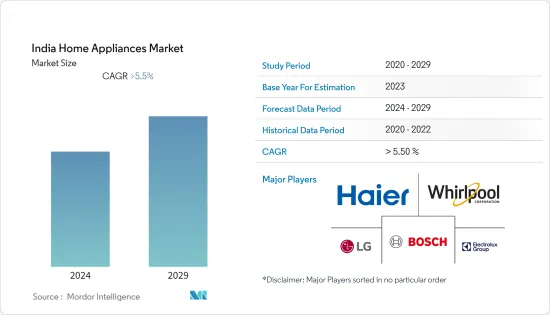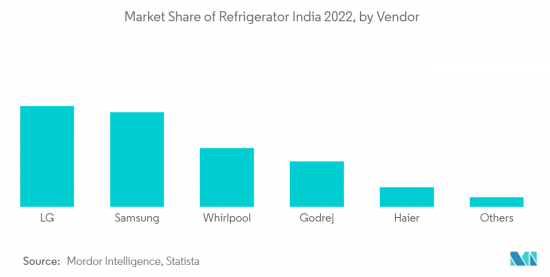PUBLISHER: Mordor Intelligence | PRODUCT CODE: 1403942

PUBLISHER: Mordor Intelligence | PRODUCT CODE: 1403942
India Home Appliances - Market Share Analysis, Industry Trends & Statistics, Growth Forecasts 2024 - 2029

Indian Home Appliances Market has generated USD 75 Billion in the current year and is poised to achieve a CAGR of 5.5% for the forecast period.
The home appliance industry is one of the fastest expanding in the Indian market. Home appliances in India have been expanding steadily, driven by both large and small appliances. In 2022, most household appliance categories had growth in both retail volume and current value. The industry has a sizable untapped market for appliances such as air conditioners (AC), washing machines, and refrigerators.
The growing economy and changing lifestyles of Indian consumers have resulted in an increase in the number of working individuals, nuclear families, single-person homes, and job migration. As a result, these emerging homes have a growing need for accessibility and are looking for items that provide convenience while significantly reducing the time and effort spent on daily activities. The emphasis on energy-efficient products, rising digital penetration, and rising aspirations are the key growth factors for this market. India's policies have undergone a tremendous transformation, particularly those that deal with the commercial and regulatory environments.
The industry may experience significant legislative changes as a result of the appliances sector and the impending national policy for electronics (NPE). The growing urban middle class and aspirational demand from rural India, together with government changes such as GST, are causing the appliances industry to look forward to the next phase of exponential expansion. This increase in India's consumer market demand is mostly driven by rising disposable incomes in Indian households and easy credit availability, which results in increased spending power. Increased electrification of rural regions, as well as the growing influence of social media and the popularity of online purchases, are all anticipated to drive up demand.
Due to COVID-19, lockdowns and social distancing, measures affected retailers with physical stores more than online retailers, ultimately accelerating the shift from brick-and-mortar to online retailing. It effected the major suppliers for the raw materials (used to manufacture devices) as well as the finished products. The industry faced a reduction in production, disruption in supply, and price fluctuations. While this has vastly encourage local manufacturers to step up and address the growing demand, the scarcity of raw material was still a challenge to this industry.
India Home Appliances Market Trends
The Refrigerators Segment Accounts for a Significant Market Share
Refrigerators are regarded as a safe, simple, and practical method of preserving food and food goods. Rising disposable income, the availability of smart and energy-efficient refrigerator units, and the expansion of nuclear families are all driving rising demand for refrigerators for domestic usage. Single-door refrigerators are the most common door type since they are inexpensive, simple to use, and may or may not have an inbuilt freezer.
A remarkable achievement for the Indian refrigerator market, which had a total market value of USD 4,602.6 Million in 2022, were the 13,804 thousand units of refrigerators sold in India. In the India Refrigerator Market, sales of refrigerators with capacities between 200 and 499 litres account for more than 63% of total sales revenue. Indian customers have adopted new technology more frequently as a result of their progress, including connected and intelligent refrigerators. As a result, producers are increasing the number of products they sell, including refrigerators with smart features like Wi-Fi connectivity, voice control, and temperature sensors. These features enhance user experience and persuade customers to switch to more contemporary devices. With manufacturers focusing on introducing new technologies, improving their product offerings, and increasing their presence in tier-2 cities, the market is expected to continue to grow at a steady pace in the forecasted period.

Increase in Smart Home Appliances is Driving the Market
The market for smart home appliances is registering healthy growth, driven by the increasing number of smart homes globally and specifically in India, the advancements in home automation, and the rising inclination of people to cook at home. Further, the increasing number of home remodeling or home improvement projects, is spurring the use of smart appliances in households. Smart home appliances are also becoming easy to use with the addition of various functionalities, which are attracting user attention. Also, various developments in wireless communication and IT infrastructure that facilitate easy integration of such appliances and innovations and advancements by leading companies are boding well for the market. The rise of IoT is also facilitating the growth of the market. With the use of IoT, various appliances will be able to interconnect with one another.
Further, growing urbanization, better lifestyles, increasing disposable income levels, and the need for convenience are driving interest in smart home appliances. Smart washing machines lead the market, supported by the growing Internet and smartphone penetration. The convenience and luxury associated with such appliances are driving their demand. Product innovation, new product development, product differentiation, and integration of numerous value-added features are further expected to catapult Indian appliances market demand over the forecasted period.
India Home Appliances Industry Overview
The Indian home appliance market is competitive and moderately consolidated, as top players have a high market share in the industry of big and small appliances. Some of the major players are Electrolux AB, Haier Electronics Group Co Ltd, LG Electronics, Robert Bosch GmbH, Whirlpool Corporation, and Samsung, among others. Consumers have been becoming more technical understanding, and the manufacturers should be able ready to offer the best technological advancements to the users, thereby, increasing the investment into R&D. According to a source, over 35% of the Indian population lived in an urban area, which is expected to rise in the coming years. This creates an enormous opportunity for the smart home market players.
Additional Benefits:
- The market estimate (ME) sheet in Excel format
- 3 months of analyst support
TABLE OF CONTENTS
1 INTRODUCTION
- 1.1 Study Assumptions and Market Definition
- 1.2 Scope of the Study
2 RESEARCH METHODOLOGY
3 EXECUTIVE SUMMARY
4 MARKET DYNAMICS AND INSIGHTS
- 4.1 Market Overview
- 4.2 Market Drivers
- 4.2.1 Increasing Disposable Income and Urbanization
- 4.2.2 E-commerce and Digital Transformation
- 4.3 Market Restraints
- 4.3.1 Increased household appliance costs are impeding market expansion.
- 4.4 Market Opportunities
- 4.4.1 Technological Advancements:
- 4.4.2 Shift towards Energy Efficiency
- 4.5 Industry Attractiveness: Porter's Five Forces Analysis
- 4.5.1 Threat of New Entrants
- 4.5.2 Bargaining Power of Buyers
- 4.5.3 Bargaining Power of Suppliers
- 4.5.4 Threat of Substitutes
- 4.5.5 Intensity of Competitive Rivalry
- 4.6 Industry Value Chain Analysis
- 4.7 Technological Innovations driving the sales in the market
- 4.8 Government Regulations and Initiatives (Make in India, National Policy on Electronics, etc.)
- 4.9 Impact of COVID-19 on the Market
- 4.10 Insights on Setting up of Manufacturing Plants for Home Appliances in India
- 4.11 Insights on the Consumer Expenditure on Home Appliances and White Goods
5 MARKET SEGMENTATION
- 5.1 By Product
- 5.1.1 By Major Appliances
- 5.1.1.1 Refrigerators
- 5.1.1.2 Freezers
- 5.1.1.3 Dishwashing Machines
- 5.1.1.4 Washing Machines
- 5.1.1.5 Cookers and Ovens
- 5.1.2 By Small Appliances
- 5.1.2.1 Vacuum Cleaners
- 5.1.2.2 Small Kitchen Appliances (Food Procesors, Air Fryers, Mixer Grinders)
- 5.1.2.3 Hair Clippers
- 5.1.2.4 Irons
- 5.1.2.5 Toasters
- 5.1.2.6 Grills and Roasters
- 5.1.2.7 Hair Dryers
- 5.1.2.8 Water Purifiers
- 5.1.1 By Major Appliances
- 5.2 By Distribution Channel
- 5.2.1 Multi-Branded Stores
- 5.2.2 Exclusive Stores
- 5.2.3 Online
- 5.2.4 Other Distribution Channels
6 COMPETITIVE LANDSCAPE
- 6.1 Market Concentration Overview
- 6.2 Company Profiles
- 6.2.1 Electrolux AB
- 6.2.2 Haier Electronics Group Co. Ltd
- 6.2.3 LG Electronics
- 6.2.4 Samsung India Electronics Pvt. Ltd
- 6.2.5 Whirlpool Corporation
- 6.2.6 Godrej Group
- 6.2.7 Blue Star Ltd
- 6.2.8 Voltas Ltd
- 6.2.9 IFB Home Appliances
- 6.2.10 Hitachi
- 6.2.11 Hoover Candy Group
- 6.2.12 IRobot
- 6.2.13 Koninklijke Philips
- 6.2.14 Videocon Industries Limited
- 6.2.15 Midea Group
- 6.2.16 Panasonic*
7 FUTURE MARKET TRENDS
8 DISCLAIMER AND ABOUT US




